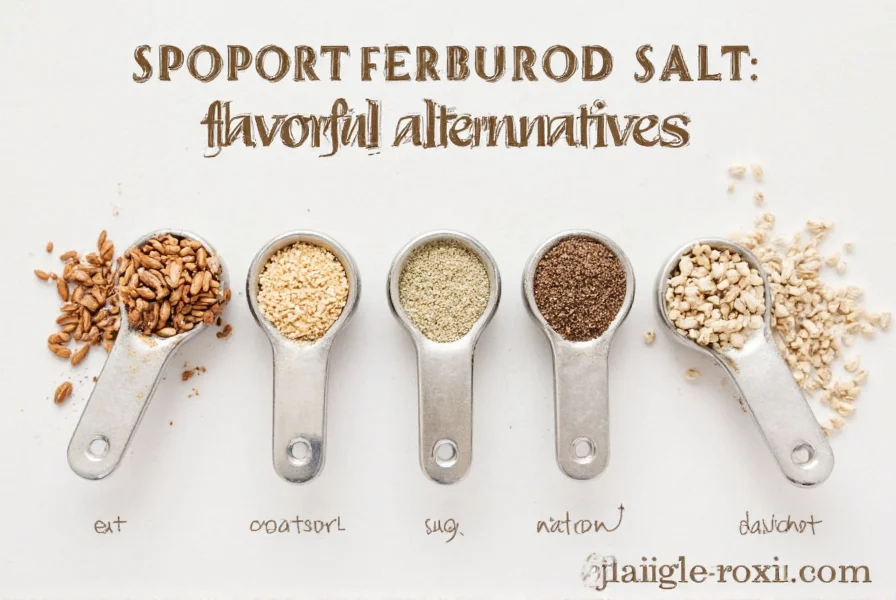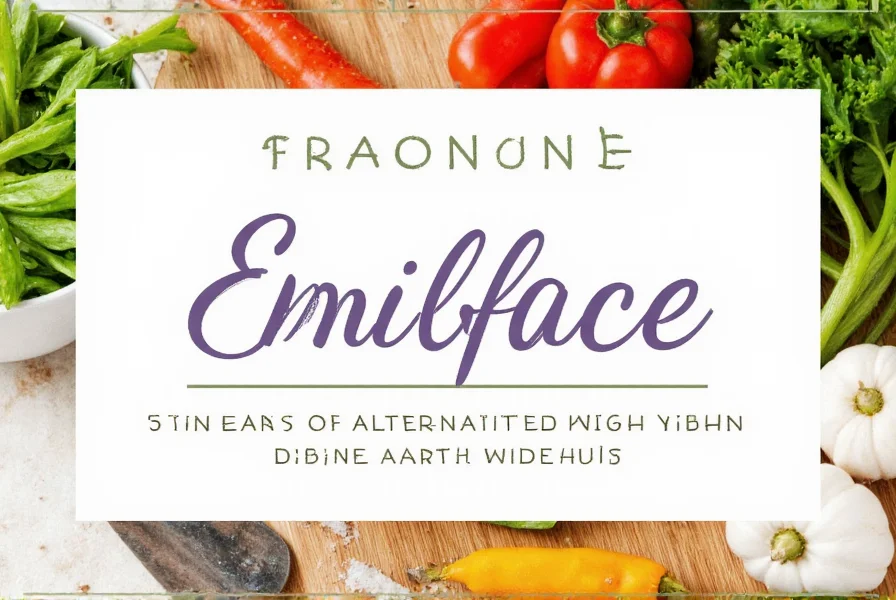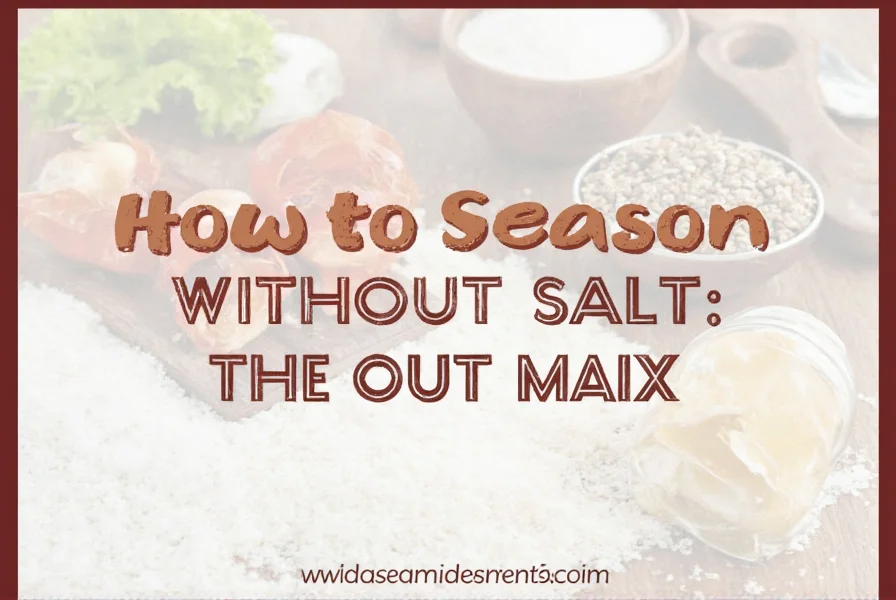Reducing sodium intake doesn't mean sacrificing flavor. Whether you're managing hypertension, following a doctor's recommendation, or simply exploring healthier cooking methods, learning how to season without salt opens up a world of culinary possibilities. The key lies in understanding flavor chemistry and strategically using natural ingredients that enhance taste perception without relying on sodium.
Understanding Flavor Enhancement Without Salt
Salt works by suppressing bitterness and enhancing other flavors, but numerous alternatives can achieve similar results through different mechanisms. When you remove salt from your cooking, you're not just taking something away—you're creating space for more complex flavor profiles to emerge. This approach to seasoning without salt requires understanding the five basic tastes (sweet, sour, bitter, umami, and salty) and how to balance them.

Core Categories of Salt-Free Seasoning
Successful salt-free cooking relies on mastering several categories of flavor enhancers. Each category works through different biochemical pathways to stimulate your taste receptors, creating the perception of fullness and satisfaction in food.
1. Fresh and Dried Herbs
Herbs provide aromatic complexity without sodium. Fresh herbs generally deliver more vibrant flavor, while dried herbs offer concentrated intensity. When learning how to add flavor without salt, consider these pairings:
| Herb | Best With | Usage Tip |
|---|---|---|
| Basil | Tomatoes, chicken, fish | Add at the end of cooking to preserve volatile oils |
| Rosemary | Lamb, roasted vegetables, breads | Use sparingly; strong flavor can dominate |
| Cilantro | Mexican, Asian, and Indian dishes | Add fresh at the end; heat diminishes flavor |
| Thyme | Stews, soups, roasted meats | Works well dried or fresh; infuses slowly |
2. Spices for Depth and Complexity
Spices create warmth, depth, and complexity that can mimic the satisfying mouthfeel salt provides. When exploring sodium-free seasoning techniques, remember that toasting whole spices before grinding releases essential oils that dramatically increase flavor impact. Cumin, smoked paprika, turmeric, and coriander are particularly effective for creating the perception of richness without salt.
For those following low-sodium diets, creating custom spice blends eliminates the hidden sodium found in commercial mixes. A simple salt-free 'everything' blend might include equal parts garlic powder, onion powder, dried dill, and sesame seeds—perfect for seasoning vegetables, proteins, or even popcorn.
3. Acidic Elements for Brightness
Acids work magic in salt-free cooking by brightening flavors and creating the perception of saltiness. When you're learning how to season without salt, incorporate these acid sources:
- Citrus juices and zests (lemon, lime, orange)
- Vinegars (apple cider, balsamic, rice wine)
- Wine and fortified wines (sherry, vermouth)
- Yogurt and buttermilk
Professional chefs often add acid in multiple stages of cooking—during preparation, while cooking, and as a finishing touch. This layering technique creates multidimensional flavor that compensates for the absence of salt. Try finishing roasted vegetables with a splash of lemon juice or adding a tablespoon of apple cider vinegar to bean dishes to enhance overall flavor perception.
4. Umami Powerhouses
Umami, the fifth taste, provides the savory depth often associated with salt. Natural umami sources make excellent sodium-free alternatives to salt for cooking. Incorporate these ingredients:
- Mushrooms (especially dried shiitake)
- Tomato paste (concentrated)
- Miso paste (use low-sodium varieties)
- Nutritional yeast
- Anchovies (in small quantities for non-vegetarian dishes)
A simple technique for building umami without salt is to create a mushroom 'tea' by steeping dried mushrooms in hot water, then using this flavorful liquid as a base for soups and sauces. Just one dried shiitake mushroom can transform a cup of water into a deeply savory broth.
5. Aromatic Foundations
The flavor base of many cuisines—onions, garlic, celery, and carrots—creates natural sweetness and complexity when properly caramelized. When mastering healthy alternatives to salt for cooking, take time to properly develop these aromatics:

- Sweat onions slowly over medium-low heat until translucent (about 10 minutes)
- Add garlic in the last 2-3 minutes to prevent burning
- Include celery and carrots for mirepoix (French) or soffritto (Italian)
- Consider adding ginger, lemongrass, or shallots for Asian-inspired dishes
This slow development of aromatics creates natural sugars and complex compounds that provide the flavor foundation salt would normally supply.
Practical Implementation Strategies
Transitioning to salt-free seasoning requires technique adjustments. These natural flavor enhancers for low-sodium diets work best when implemented strategically:
Layering Technique
Don't add all seasonings at once. Introduce different elements at various cooking stages:
- Base layer: Aromatics (onions, garlic) at the beginning
- Middle layer: Dried herbs and spices that need time to infuse
- Finishing layer: Fresh herbs, acids, and delicate flavors
Taste and Adjust Method
When cooking without salt, taste frequently and adjust incrementally. Your palate needs time to recalibrate. After 2-3 weeks of reduced sodium, your sensitivity to other flavors increases significantly. What might seem 'bland' initially will gradually reveal complex flavor notes you previously missed.
Texture Considerations
Texture affects flavor perception. Crispy elements (toasted nuts, breadcrumbs, seared surfaces) create satisfying mouthfeel that compensates for reduced sodium. Try finishing dishes with:
- Toasted seeds (pumpkin, sesame)
- Crispy roasted chickpeas
- Herb-infused oils
- Finely diced fresh vegetables for crunch
Common Challenges and Solutions
When first adopting these best herbs and spices to replace salt, you might encounter these challenges:
'Bland' Perception
Solution: This is often temporary as your taste buds adjust. Increase aromatic ingredients gradually. Add a small amount of acid (lemon juice or vinegar) at the end of cooking—this tricks your brain into perceiving more complexity.
Food Seems Flat
Solution: You're likely missing the umami component. Add a tablespoon of tomato paste to soups and stews, or include mushrooms in vegetable dishes. A small amount of miso paste (dissolved in warm water) can transform bean dishes.
Difficulty with Certain Dishes
Solution: Some foods naturally require more seasoning. For potatoes, try roasted garlic and rosemary. For eggs, add fresh dill and a squeeze of lemon. For grilled chicken, use a marinade of citrus, herbs, and a touch of honey.
Creating Lasting Flavor Habits
The transition to salt-free cooking becomes easier with practice. Within 4-6 weeks, your palate adapts, and previously 'normal' salt levels will taste overwhelmingly salty. Document your seasoning experiments in a journal, noting which combinations work best for different dishes. Over time, you'll develop an intuitive understanding of how to create deeply flavorful meals without relying on sodium.
Frequently Asked Questions
What's the best immediate substitute for salt when cooking?
Lemon or lime juice provides the most immediate flavor enhancement that mimics salt's brightening effect. A small splash (1-2 teaspoons per serving) added at the end of cooking can transform bland dishes by stimulating saliva production and enhancing other flavors without sodium.
How can I make soups flavorful without salt?
Build flavor from the foundation up: sauté aromatics (onions, celery, carrots) until caramelized, add dried mushrooms or tomato paste for umami, include dried herbs early in cooking, and finish with fresh herbs and a splash of acid like apple cider vinegar. Simmering with a Parmesan rind (if not dairy-free) adds significant depth without salt.
Will my food taste bland if I stop using salt?
Initially, food may seem less intense as your palate adjusts, but within 2-4 weeks, your taste buds become more sensitive to other flavors. Most people find their food tastes more complex and nuanced after this adjustment period. The key is properly layering herbs, spices, acids, and umami sources to create multidimensional flavor profiles that salt alone cannot provide.
Can I use salt substitutes safely?
Many salt substitutes contain potassium chloride, which can be problematic for people with kidney issues or those taking certain medications. Before using commercial salt substitutes, consult your healthcare provider. Natural alternatives like herbs, spices, and acids provide safer, more complex flavor enhancement without potential health concerns.











 浙公网安备
33010002000092号
浙公网安备
33010002000092号 浙B2-20120091-4
浙B2-20120091-4